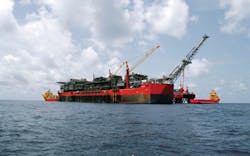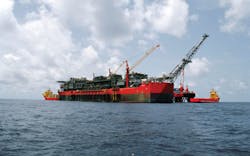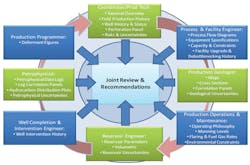Deepwater brownfield strategy improves operations offshore Nigeria
Well, reservoir, and facility management process requires integration, collaboration
Emmanuel Udofia, Femi Eruja, Kazeem Lawal
Shell Nigeria Exploration & Production Co.
Brownfield projects are challenging because of the need to reduce production deferment, optimize production in real time, and operate the field in a safe and environmentally friendly manner. Hence, it is important to develop an empirically-based structure and processes that can effectively manage these challenges. The solid foundation to effectively manage these complexities is to put in place a robust well, reservoir, and facility management framework built around strong cross-functional collaboration in a co-located environment supported by state-of-the-art techniques.
TheBonga field, Nigeria’s first deepwater development, is about 120 km (74.6 mi) offshore in the Gulf of Guinea in a shale-induced block OML 118. Production began in 2005. The reservoirs are located in a water depth of 1,000 m (3,281 ft) and are primarily under saturated and characterized by an average 30% porosity and Darcy-range permeability. Following the recent tieback of the Bonga North West wells to the FPSO, there are 18 active producers and 14 active water injectors. Current oil production and water injection rates are in excess of 200,000 b/d and 300,000 b/d, respectively. SNEPCo (55%) operates the license on behalf of the Nigerian National Petroleum Corp. in partnership with Esso Exploration and Production Deepwater Ltd. (20%), Total E&P Nigeria Ltd. (12.5%), and Nigerian Agip Exploration Ltd. (12.5%).
The brownfield development strategy is to sustain water injection for the purposes of pressure-maintenance and improved sweep efficiency. Given that the water injection and oil production subsea systems are strongly coupled in this prolific field, the management of wells, reservoirs, and facilities remain challenging. The appreciation of these challenges and the need to overcome these challenges gave birth to the so-called concept of wells, reservoirs, and facilities management (WRFM).
The Bonga WRFM strategy is built around the following objectives:
- Achieve high sweep efficiency, hence improved recovery factor in reservoirs
- Maintain reservoirs above bubble-point pressure by ensuring full voidage-replacement with water injection
- “Make it grow” through continuous production system optimization as a means of sustaining short- to medium-term oil production.
In October 2014, an assessment of the Bonga WRFM capabilities and processes was carried out by experts from Shell’s global WRFM team. The assessment confirmed that Bonga’s WRFM is in the top-quartile and approaching “best-in-class” level. The following describes how the implementation of the WRFM framework resulted in the faster turnaround time in integrity management, real-time production monitoring and optimization, with enhanced work culture built around operation integration and collaboration.
Smart Fields value loop
Attaining and sustaining high-quality WRFM requires effort, the right work culture, tools, facilities, and processes. To achieve this, Bonga is built around the WRFM Smart Fields value loop. According to Udofiaet al(2013), the value loop concept describes how various components supporting the operation are identified and linked to generate the expected value of top-quartile well, reservoir, and facility performance. It must be acknowledged that WRFM is very broad; complexities vary between assets in relation to specific challenges. As a result, the authors will focus on the key ingredients of the Bonga field experience in fixing the basics, building a solid foundation, and continuous system improvement.
Fixing the basics ensures that established WRFM minimum standards are met. During WRFM assessment the “value loop” concept is used, creating the foundation for fixing the basics and resourcing the consequent asset improvement plan. From Al-khadhuriet al (2013), the key elements in this process include:
- Data gathering and management
- Well integrity management
- Well optimization and restoration effort
- Effective reservoir management strategy
- Surveillance strategy
- New technology implementation.
It is important to note that many assets use different ways to fix the basics but the clear objective is that this must be compared against a set standard with the overall aim that the basic standard for WRFM is achieved.
Integrated WRFM reviews are important in fixing “the basics” and realizing the potentials of any WRFM process in an asset (Ayoola & et al 2010). The relevant components of this value loop element are daily production review (DPR), monthly reviews, quarterly production system optimization, and annual reviews. All these reviews are multi-disciplinary, enabling full integration. In general, these reviews are essentially a feedback mechanism, where trends are identified and used to predict the future. From these trends, potential threats and opportunities are identified and relevant mitigation developed. The main aspects of a WRFM review process are illustrated in the associated chart.
The Bonga asset has embedded these review processes resulting in positive impacts on the delivery of the business objectives. For example, the Bonga WRFM review meetings are always interdisciplinary. As a minimum, the production technologist, production programmer (engineer), reservoir engineer, production chemist, subsea (well services) engineer, production operations engineer, and process/facility engineer must be in attendance.
The following highlights key elements of the Bonga WRFM system.
Updated models
The Bonga asset has state-of-the-art well, reservoir, and facility models. These include an integrated production system model, which is a suite of applications covering reservoir, wells, and facilities. With this integrated network model, the impact of system changes and disturbances on any component of the integrated system can easily be assessed. For realistic forecasting, planned and unplanned deferments as well as possible loss of well potentials are incorporated. As part of optimization, the distribution of injection water and allocation of production to the various wells are easily simulated (Udofia et al, 2013). The integrated production system model (IPSM) is maintained “live” by a joint team of the process engineer, reservoir engineer, production technologist, and production engineer (program).
Subsurface models are always uncertain. To facilitate the maturation of the Bonga subsurface models and reduction of subsurface uncertainties, the WRFM team drives the planning and acquisition of relevant data such as interference testing, tracer injection, routine production testing, pressure-transient testing, and the management of the various data-acquiring flow meters and pressure/temperature sensors installed in the network.
The Bonga asset has been able to develop techniques for good understanding of subsurface performance despite some unique challenges in connectivity and flow capacity. Interference tests are carried out to demonstrate the connectivity effectiveness between the producer and pair water injector with monitoring of reservoir pressure changes of the producer against the pair injector. Pressure build-up data is acquired to provide information on well and reservoir parameters. Tracer injection into injectors is done to establish the contribution from different injectors located in same reservoir.
Real-time monitoring
Well testing is the process required to calculate the volumes (oil, water, and gas) of production or injection from or into a well in a bid to identify the current state of the well. Normally, as a means of production health check, a reconciliation factor is generated by comparing the fiscal production volume against the theoretical well test volume. In most deepwater operations, including the Bonga field, well testing is always a challenge because of flow assurance concerns and associated production deferment.
To mitigate the related challenges while still ensuring quality allocation of volumes, a proprietary application called Production Universe (PU) is used. This data-driven application performs real-time production monitoring in the Bonga field. It uses real-time information from test separator flow meters, chokes as well as pressure for the calculations.
Routine well tests in deepwater operations are challenging and PU assists in addressing this challenge because the real-time well-by-well estimates from the system are like testing each well 24 hours every day. Bonga use the half-yearly maximum efficient rate well test window, which is statutorily required, to model and maintain the PU models for effective real-time well-by-well production monitoring. This application plays a pivotal role in production monitoring, reconciliation, and relocation process in the Bonga asset. It also assists in exception-based surveillance and real-time production optimization. As inferred from historic monthly reconciliation factors, PU is accurate to within 5% from historical performance.
Subsea intervention
Bonga is heavily dependent on a subsea support structure for speedy reaction to wells and subsea issues. This capability reduces production/injection deferments and preserves the well integrity and other subsea appurtenances. A dedicated field support vessel, theAfrica Vision, provides the readiness to react quickly to subsea hardware and software failures. As a responsible operator, well integrity is a top priority in the Bonga asset. For effective management, the operator uses the electronic well integrity management standard (eWIMS) and conducts regular well leak-off-tests. A leak-off-test is an integrity test performed every six months on a well barrier system. This system provides prompts and repository for regular integrity tests of various well valves, which serves as a barrier to protect the environment and facilities from potential hydrocarbon and high-pressure discharges.
Bonga WRFM plan
This is a document that defines the strategy and road-map for maximizing the life-cycle value of the asset. The operations and boundary conditions of various components of the integrated system as well as relevant surveillance tools are described. Although this document is designed to be updated every two years, there are provisions for more recent updates if the circumstances (such as new information) warrant such updates. The Bonga WRFM plan document provides guidance on how the asset is operated and maintained. This document remains one of the success stories of the Bonga asset.
Data management
The Bonga asset was declared Smart (Intelligent) Fields Foundation complaint in April 2008. Some of the key business objectives were to minimize manual data entry, acquire data in real-time, and ensure effective data management. The availability of “common” real-time data supports the effective production surveillance process (WRFM).
All critical well, reservoir, and facility data are available in a plant information system (data historian), which can be displayed in a process book and the WRFM IT tool-kit. All Bonga wells are equipped with permanent downhole gauge; though only 80% of the gauges are functional (there are on-going efforts to fix the defective gauges). The data acquisition architecture has a dual plant information system that ensures that no data is lost even in situations of system or signal outage in the office domain.
Key applications, which support this robust process, include:
- Fieldware Production Universe for production monitoring
- Fieldware well test for well test calculation and control
- Energy components as production data historian
- Oil field manager for data analysis
- Integrated production system model for opportunity generation
- Plant information system as data historian.
Review process
The daily production review (DPR) is a process where production/water injection performance is compared against the integrated production system capacity (IPSC) to obtain a common understanding of the field performance and offer appropriate mitigation actions, if required. For the last nine years, the Bonga field DPR process has continuously improved in terms of personnel, quality of reviews, and efficiency of the meetings.
In the Bonga asset, the DPR starts with exception-based surveillance of all the wells using the WRFM IT tool-kit within an integrated cross-functional Bonga WRFM team. Reviews of the previous outstanding action items are also conducted with an action tracker. The output of the discussion forms the agenda for the immediate meeting with the field during the morning call. This ensures common understanding of the issues in the last 24 hours between the office and field personnel. The action items in this process are tracked and executed as agreed on by the team.
The Bonga DPR process is the “engine” of the WRFM structure as cross-functional integration and collaboration takes place within this space every morning. This process has provided the right platform for effective and quick decision making, hence reduced turn-around in the resolution of challenges.
Collaborative environment
Collaborative work environment (CWE) is an enhanced operation integration concept through the use of seamless connection of tools, defined processes, people, and a tele-presence facility. A collaborative environment is any form (physical or virtual) in which teams can come together to discuss in a bid to reach a common decision. It is expected, the solutions from this implementation will provide a common data set for faster decision-making through collaboration between functions or teams regardless of location.
The go-live of Bonga asset operations collaboration center took place in November 2014. The first business process to be deployed was the DPR. Already, the benefits of “knowing sooner and act faster” concept are being recognized. Other advantages include, reduction of field visits since support can be provided from onshore using this facility. It equally enhances team integration and speed in quality decision-making. To support this process all core WRFM team members are co-located in a common space for effective team integration and collaboration. Addition of other solutions is planned in the future with “smart-mobile-worker” capabilities.
Conclusion
Effective well, reservoir, and facility management in brownfield projects like Bonga is important to sustain and grow production. It is recognized that the addition of new solutions through enhanced technology and business processes assist in achieving this goal. Hence, constant effort must be made to look for new ways to grow the WRFM concept in other to remain in the top-quartile.
References
Al-Khadhuri, S.M, M.M. Al-Harthi and A. Alkalbani (2009): ‘Oman’s Large Carbonate Field Production Improvement through Integrated Well, Reservoir and Facility Management’ Paper IPTC 16523, presented at International Petroleum Technology Conference held in Beijing China 26-28 March 2013
Ayoola, O. T, Uruh O., Odizuru-Abangwu Ijeoma, Dike Amadi, Mgbaja Boniface, Folorunso Gbenga, Kalu Patricia (2010) ‘Maximising Value from Integrated Well and Reservoir Management & Facilities Reviews: A 2-Field Case Study from the Niger Delta’ Paper SPE 140624, presented at 34th SPE International Conference and Exhibition held in Tinapa - Calabar Nigeria 31 July-07 August 2010
Udofia, E., Oni, O., A., Chaker and O. Oghedegbe (2013) ‘Smart Fields Management in Deepwater Field: Experience & Perspectives’ Paper OTC 24078 presented at Offshore Technology Conference held in Houston Texas, 5-9 May 2013
Acknowledgments
Based on a paper presented at Offshore West Africa Conference held in Lagos, Nigeria, Jan. 26-28, 2016. The authors wish to express appreciation to NNPC/NAPIMS (the Nigerian government), the management of Shell Nigeria Exploration and Production Co. and partners (Total, Agip, and ExxonMobil) for the permission to present and publish this paper. They also like to recognize the effort and contribution of the Bonga WRFM team and all support functions.


